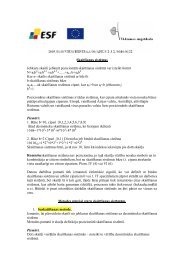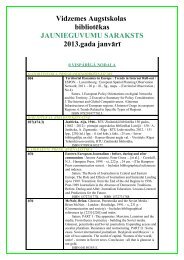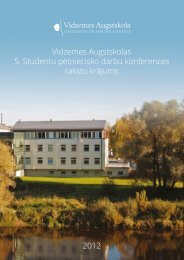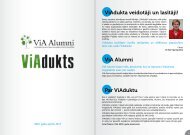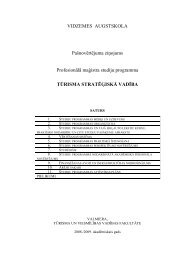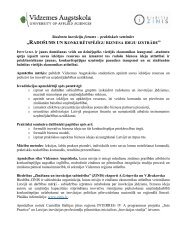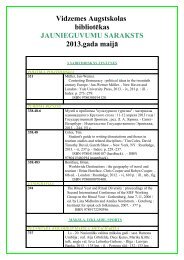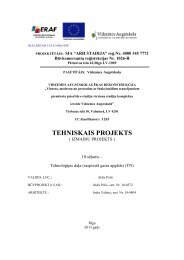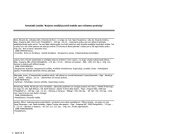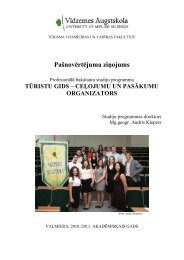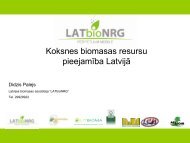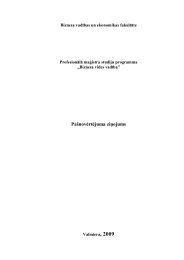Proceedings
Proceedings
Proceedings
You also want an ePaper? Increase the reach of your titles
YUMPU automatically turns print PDFs into web optimized ePapers that Google loves.
Sustainable Planning Instruments and Biodiversity Conservation<br />
Lek 1 (BP Lek 1) was situated on the open reach fen<br />
Dikoe. The number of males at the lek was stable<br />
(Figure 7). Annually 9 to 15 males were registered there.<br />
At the distance of 900 m from the main Lek 1, a small lek<br />
with 3 to 5 males was additionally discovered.<br />
Monitoring of the Great Snipe on the territory of the<br />
Berezinsky Reserve was conducted on two leks since<br />
2001 (Figure 8). These leks were situated on floodplain<br />
pasturable meadows of the Berezina River. Lek BR 1<br />
was situated in the vicinity of the Brody village, and<br />
the number of males in this lek strongly fluctuated. In<br />
2007, Lek BR 1 moved 800 m from its previous site, and<br />
in 2008 displaying males were not found on the former<br />
display grounds or in nearest vicinity (1–1.5 km). Lek<br />
BR 2 was situated in the vicinity of the Berezino village.<br />
The number of males at the lek varied from 5 up to 18<br />
individuals. A strong decrease in the male numbers was<br />
registered in 2002.<br />
Discussion<br />
The Black Grouse<br />
Long-term monitoring and analized archive data on<br />
the Black Grouse on the territory of the Belovezhskaya<br />
Puscha made it possible to estimate the Black Grouse<br />
population dynamics and to analyze the reasons for<br />
changes.<br />
The greatest number of Black Grouse in the<br />
Belovezhskaya Puscha was, probably, after the great fires<br />
in 1812 and 1834. At that time, vast territories suitable for<br />
this species had been formed. Thus, for example, Brinken<br />
(1828), who visited the Puscha in 1826, mentioned the<br />
Black Grouse as a very abundant species. But in the<br />
middle of the 19 th century, this species was registered<br />
only in several places (Stralborg, 1861). At the end of<br />
the 19 th century and at the beginning of the 20 th century<br />
the Black Grouse was a rather rare species (Auer, 1898;<br />
Kartsov, 1903). By the end of the 19th century, burnt-out<br />
places in the forest had been already overgrown. As a<br />
result, the Black Grouse, an inhabitant of small-leaved<br />
and coniferous low forests, could not find optimal<br />
habitats among the old and high forests of the Puscha.<br />
By that time, river channels where the Black Grouse<br />
could dwell had also changed substantially. The analysis<br />
of map materials (Afforestation Plan of 1860) shows<br />
that dwelling places of Black Grouse began to change<br />
substantially in the middle of the 19 th century. Exactly<br />
at that time waterlogged floodplains of rivers were used<br />
as hayfields, which caused the destruction of shrubs and<br />
wood thickets along the river banks – native habitats of<br />
the Black Grouse. Later on, raised bogs became the main<br />
habitats of the Black Grouse.<br />
For the first time, data on the number of Black<br />
Grouse in the Belovezhskaya Puscha were provided<br />
by S. A. Severcov in 1939–1940. During this period<br />
he counted 400 individuals of the Black Grouse on the<br />
70<br />
territory of the Belovezhskaya Puscha (Severcov, 1940).<br />
However, the author did not indicate at what time the<br />
census was conducted and what method was used.<br />
The more detailed study of the Black Grouse<br />
populations was commenced by Gavrin at the end of<br />
the 1940s. During the period from 1948 to 1952, the<br />
Black Grouse was numerous on the territory of the<br />
Puscha, but concentrated unevenly in small regions.<br />
The main dwelling regions of the Black Grouse were<br />
mainly confined to the external borders of the reserve,<br />
with low birch forests on mires or floodplain meadows.<br />
The Black Grouse was rare in the central woodlands of<br />
the reserve. There, the Black Grouse was found only<br />
on extensive clearings amongst pine forests, where<br />
pine saplings had a significant mixture of birch and<br />
aspen. The significant wood fellings during the period<br />
from 1916 to 1941 in great plots, and the appearance of<br />
mixed saplings promoted the penetration of the Black<br />
Grouse into the heart of the forest. Black Grouse settled<br />
in the places where clearings occupied large areas of<br />
~100–150 ha, divided by the narrow bands of high pine<br />
forests, and forming, as a whole, areas of 200–300 ha.<br />
Close to the external borders of the woods of the reserve,<br />
Black Grouse settled on isolated clearings with an area<br />
of 30–50 ha (Gavrin, 1953). The process of reducing the<br />
areas of biotopes suitable for the Black Grouse began in<br />
the 1940s (Gavrin, 1956). At the end of the 1950s and<br />
the beginning of the 1960s, clearings gradually became<br />
unfit for the Black Grouse as the age of trees exceeded<br />
25 years.<br />
Since 1960, there were no Black Grouse witnessed<br />
in the Puscha woodlands. The whole Black Grouse<br />
population concentrated on the edges of the Puscha<br />
(Figure 3). In the following decade, optimum lands of the<br />
main type of Black Grouse dwelling were rarely drained<br />
and ploughed. As a result, their area was reduced by 90%.<br />
Naturally, the number of Black Grouse also strongly<br />
decreased. Thus, in 1969 only five leks with several tens<br />
of displaying males were counted (Datskevich, 1971).<br />
Although during the last years extensive open<br />
territories have appeared as a result of clear-cuttings,<br />
penetrating of Black Grouse inside woodlands, as it<br />
happened in the 1950s, was not observed. Exceptions<br />
were the leks which appeared in 2000 on the mires<br />
Glubokoe and Orlovo due to their overgrowth. The area<br />
of these mires decreased by 231 ha from 1982 to 1992.<br />
Substantial overgrowth on the edges of the fen Dikoe<br />
created suitable conditions for Black Grouse dwelling. At<br />
present, the most stable leks are located on the territory<br />
of this fen.<br />
Thereby, we and others closely tie the number of<br />
the Black Grouse on the territory of the Belovezhskaya<br />
Puscha to the presence of marshes and new woodless<br />
territories. In the past, the maximum number of the Black<br />
Grouse was noted after strong, vast wildfires. Currently,<br />
Numbers of Black Grouse<br />
30<br />
25<br />
20<br />
15<br />
10<br />
5<br />
0<br />
1999 2000 2001 2002 2003 2004 2005 2006 2007 2008<br />
Black Grouse dwell on mire areas and on the peripheries<br />
of the Puscha in insignificant numbers. It is necessary<br />
to note that in the last decade displaying birds occupy<br />
larger territories and display not so tightly as in 1950s.<br />
Moreover, unsteady leks with solitary or few birds have<br />
also appeared. In the opinion of Potapov (1990), single<br />
display is observed on the bounds of areals or in places<br />
with low population densities. The negative factors<br />
that influence the number of the Black Grouse in the<br />
Belovezhskaya Puscha are not only the transformation<br />
of natural habitats but also increased predator pressures<br />
and hunting within the buffer territories. It has been<br />
established that the disappearance of two leks of the<br />
Black Grouse was caused by mass shootings of males.<br />
In the Berezinsky Reserve, traditional places of the<br />
Black Grouse displays, in contrast to the Belovezhskaya<br />
Puscha, were situated on raised peat-bogs, the area of<br />
which totals 6,600 ha. The most stable conditions for<br />
the Black Grouse exist in these habitats. The numbers of<br />
birds there do not undergo significant fluctuations, such<br />
as at Lek BR 1 (Figure 5). The sharp decline of displaying<br />
birds in 2006 was likely due to the concomitant growing<br />
numbers of red fox on the territory of the reserve during<br />
the same year (Figure 9). At the same time, the dynamics<br />
at Lek 2, located on the drained peatery squares was<br />
likely connected with hunting (shootings in 2000). The<br />
condition of the habitat was stable during the past 10<br />
years, since continual mowing prevents shrub and tree<br />
overgrowth, and thus determines the stability of the<br />
conditions required for spring Black Grouse displays.<br />
The dynamics at Lek BR 2 can also be connected with<br />
movement of the birds within several leks located in the<br />
hunting ground "Barsuki", where spring hunting is held<br />
annually.<br />
The lek in the protection zone of Sq. 616, 629, 643 is<br />
also located on drained peatery squares, but unlike the<br />
Monitoring of the Great Snipe and the Black Grouse in Specially Protected Nature Territories<br />
n Fox BR lek 1 (575)<br />
Figure 9. Dynamics of the Black Grouse at Lek BR1 and the numbers of the Red Fox on the territory of the Berezinsky<br />
Reserve<br />
360<br />
300<br />
240<br />
180<br />
120<br />
Lek BR 1, there is no agricultural work conducted there,<br />
and the squares are gradually overgrown by shrubbery<br />
and trees. Hereupon, the lek constantly moves from one<br />
place to another, and the number of males visiting this<br />
lek is small.<br />
The Great Snipe<br />
In the Belovezhskaya Puscha, nesting biotopes of the<br />
Great Snipe are typically situated in reach fens. In spite<br />
of the drainage of vast tracts of mires, the remaining<br />
part of the main reach fen maintains a stable enough<br />
population of the species. The number of males at the lek<br />
did not significantly change from year to year (Figure 7).<br />
This was connected with a relatively stable water level<br />
and constant presence of favorable forage biotopes. The<br />
possible threat for the stable existence of this lek may be<br />
shrub and tree overgrowth of the open areas of the fen<br />
because of lack of mowing. Furthermore, some danger<br />
comes from changing the hydrological regime as a result<br />
of the reclamation system operating on the edge of the<br />
mire tract.<br />
In contrast to the Belovezhskaya Puscha, in the<br />
Berezinsky Reserve leks were situated on floodplain<br />
pasturable meadows of the Berezina River. The living<br />
conditions in such biotopes change more often than in<br />
the fens. First of all, the high water frequently floods<br />
places of feeding and leks and birds, as a result, move<br />
to other places. The optimal structure of vegetation and<br />
favorable forage biotopes on floodplain meadows are<br />
also connected with pasture duty.<br />
The decrease in male numbers at Lek BR 2 in 2002<br />
was connected with extremely dry conditions in the<br />
spring and the beginning of summer and low level of<br />
floods of the Berezina River (Figure 8). Obviously<br />
in this year birds have been redistributed around the<br />
favorable biotopes, and only 5 males were registered<br />
60<br />
0<br />
Numbers of Fox<br />
71



